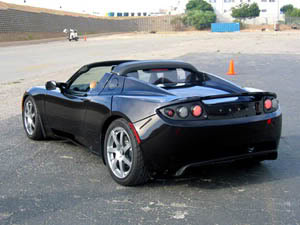This is the third in a series on how we can build an energy future based on our best science and no longer critically dependent upon exhaustible and polluting fossil fuels.
Getting off oil: a three-pronged approach
Oil is not “evil,” it’s an undervalued resource that has been squandered on tasks that could be much more efficiently achieved through the use of electric drive transport. Cheap oil has enabled individual and family mobility and autonomy at a low price but these uses now compete with more critical uses of oil in commerce, industry, and agriculture. As we shall see, with greater investment in electric transport and infrastructure an equivalent level of mobility in most arenas can be achieved through electric drive transport. Electricity can be generated via a number of different methods, some of which are sustainable and have low or zero emissions.
-
 This European high speed train receives its power through the overhead catenary wires.
This European high speed train receives its power through the overhead catenary wires.Electrified rail and roadways: In the last few months, decisions have been made in Washington to spend billions of dollars on bailing out financial institutions that made the wrong bets in the housing and housing securities markets in search of guaranteed or higher than average profits. To get off oil, we will need to make public and private investments in productive assets that enable transport to be powered by electricity, a much more durable and secure investment. Electrification of railways and key roadways, first in urban centers and then interurban roads, will allow trains, freight, and large passenger vehicles to function independently of oil supply. As electric or dual mode locomotives on electrified rights of way are more capable than the majority locomotives in the U.S., fairly inexpensive sets of financial incentives may be sufficient to encourage private railways to electrify. Compared to the other electric options, electrification of rail and local roadways is the most highly developed and highest capacity electric transport option, though the least publicized in an age fixated on new technology. This option has slipped under the radar, as, for instance, Andy Grove, the Intel co-founder and now an advocate of the electrification of transportation, omitted to mention this option in his recent Washington Post editorial on the subject.
-
 GM’s Chevy Volt will be one of the first production plug-in hybrids which GM is calling an “Extended Range Electric Vehicle” or EREV
GM’s Chevy Volt will be one of the first production plug-in hybrids which GM is calling an “Extended Range Electric Vehicle” or EREVPlug-in hybrids / extended range electric vehicles: The most likely substitutes for small and medium sized vehicles used mostly for local trips but with some longer-distance usage are PHEVs/EREVs such as the upcoming Chevy Volt. In their simplest configuration, these vehicles will be driven by an electric motor that can propel the vehicle for as many as 40 to 60 miles on stored grid electricity (therefore the “plug-in” part) in a medium-sized battery and can switch seamlessly to using petroleum or other liquid fuels from its conventional fuel tank to run either a generator or small engine to propel the vehicle on longer trips. PHEVs will benefit from new generations of batteries that are more compact than lead acid; however a future revolution in battery and quick charge technology may narrow the scope of usefulness for PHEVs. Many auto manufacturers are now planning or actually developing PHEV models, including GM and Toyota. PHEVs in wide deployment could reduce petroleum usage by as much as 60 to 70 percent.
-
 The introduction of the Tesla Roadster has sparked a revival of interest in electric cars by many major carmakers as well as by start ups.
The introduction of the Tesla Roadster has sparked a revival of interest in electric cars by many major carmakers as well as by start ups.Battery electric vehicles/battery exchange and quick charge infrastructure: A new generation of battery electric vehicles are now being developed with lithium ion batteries that can have ranges of up to 250 miles or can completely recharge within 10 minutes. The Tesla Roadster, a high end sports car with a 225 mile range is just being delivered to customers; Tesla’s British competitor with a 160 mile range, the Lightning GT, will recharge in 10 minutes from a 480 volt outlet, making its recharge time approach liquid refueling times. Tesla, Renault-Nissan, and Mitsubishi are all planning mid-market or economy electric vehicles with varying ranges all using higher energy-to-weight ratio batteries than lead-acid batteries. Other makers are making short-range vehicles for lower speed city use with the older lead-acid battery technologies. Some are planning to build quick charge or battery swap infrastructure to allow electric vehicles to travel unrestrictedly with short charging or swap stops. As is, battery electrics with even traditional lead-acid batteries can do many important tasks that are now the province of petroleum-powered vehicles.
One of the strengths of this three-pronged approach is that it does not hang its hat on any one technology, distributing risk between three paths. Also by acknowledging the uses of existing battery technology and on-grid transport options, the plan doesn’t depend crucially on innovation in batteries or chargers and their manufacture yet also would take advantage of the opportunities offered by these technologies and their future path of development.
Next up: toward a post-oil society.

